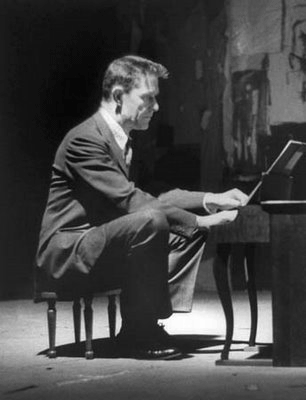« Complements of you... |
Main
| Why I like Chris Thile »
 August 27, 2009 | Respect the Silence August 27, 2009 | Respect the Silence
From ClassicalNotes.net, Peter Gutmann on John Cage and the Avant Guarde "The Sounds of Silence:"
"4'33" was Cage's favorite work. Written in 1952, it came at the exact mid-point of his 80-year life of discovery and culminated his exploration of indeterminacy, music in which some elements are carefully scripted with others left to chance. The year before, he had written his Imaginary Landscape #4 for 24 performers, each of whom adjusted the volume or tuning of one of a dozen radios; although the dial settings were exactly prescribed, the result depended upon the frequencies and formats of local stations. 4'33" was inspired by Cage's visit to Harvard's anechoic chamber, designed to eliminate all sound; but instead of promised silence Cage was amazed and delighted to hear the pulsing of his blood and the whistling of his nerves.
 Most music is trivialized by attempts to describe it. ("The melody is announced by the flutes...") That's not a problem with 4'33". Here's how one performance went: A tuxedoed performer came on stage, sat at a grand piano, opened the lid, occasionally turned some music pages but otherwise sat as quietly as possible for 4 minutes and 33 seconds, then rose, bowed and left. And that was it. Most music is trivialized by attempts to describe it. ("The melody is announced by the flutes...") That's not a problem with 4'33". Here's how one performance went: A tuxedoed performer came on stage, sat at a grand piano, opened the lid, occasionally turned some music pages but otherwise sat as quietly as possible for 4 minutes and 33 seconds, then rose, bowed and left. And that was it.
Although often described as a silent piece, 4'33" isn't silent at all. While the performer makes as little sound as possible, Cage breaks traditional boundaries by shifting attention from the stage to the audience and even beyond the concert hall. You soon become aware of a huge amount of sound, ranging from the mundane to the profound, from the expected to the surprising, from the intimate to the cosmic--shifting in seats, riffling programs to see what in the world is going on, breathing, the air conditioning, a creaking door, passing traffic, an airplane, ringing in your ears, a recaptured memory. This is a deeply personal music, which each witness creates to his/her own reactions to life. Concerts and records standardize our responses, but no two people will ever hear 4'33" the same way. It's the ultimate sing-along: the audience (and the world) becomes the performer.
Let's tackle a few obvious questions. Is this music? Sure it is - each sound has a distinct tone, duration, rhythm and timbre. Isn't it arbitrary? But so are all artistic conventions. Couldn't a 3-year old have written this piece? Perhaps. But did he? Did you?"
This was quite a historic moment in the development and definition of contemporary music, and not one that can ever be duplicated. What does it have to do with your playing? Let's use it to make a point about silence, or better, "musical space." As ensemble players, we often go out of our way to fill each performance moment with something musically interesting. Ever play with a lead guitar player who insisted on noodling the whole time, playing asymmetrically parallel to the melody? How about playing with a bass player that thinks he's Geddy Lee incarnate, and abandons the role of driving the band for distracting upper fret exploration? You might have played with a drummer the rest of the band nickname "Fill," because he feels punctuating the end of EVERY phrase is his enduring entitlement.
There is little more musicially satisfying than playing in an ensemble devoted to a healthy respect for sonic space. The goal should always be to make the other individual players of the group sound good, and there is no way to accomplish this without adequate silence. It can be as radical as sitting out a chorus or two, or as simple as just not playing through every turnaround. Trading time in the limelight gives the audience a dose of textural "freshening," and it makes players listen sensitively to each other. Interesting things happen during this silence, and we aren't talking about the peripherals of air condition, crowd conversations, or creaking doors mentioned in John Cage's 4'33". It's the impact on the music itself that is so remarkable when that breathing room between musicians is developed.
Does this problem plague your band? Challenge the other members by interrupting during practice and quizzing each other who is playing what. Stop and ask your piano player what's going on in the kick drum, or ask the guitar player what's happening in the right hand of the keyboardist. Simply disciplining yourselves to pay attention to these small details can make your ensemble sound better than ever.
Be the "Silence."
Further:
Plays Well With Others...
Ensemble Sensitivity: Corps playing
Playing with a drummer
Building off silence
Posted by Ted at August 27, 2009 5:59 AM

Disclaimer: In the 'Information Age' of the 21st Century,
any fool with a computer, a modem, and an idea can
become a self-professed 'expert." This site does not
come equipped with 'discernment.'
|



